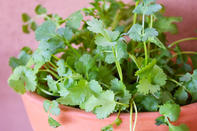Coriander originates from the Near East. The first evidence of the plant, its cultivation and use by humans is over 6 000 years ago from Egypt to Turkey, Central Asia and Persia.

Following this, the use of coriander had also spread to India and China more than 3 000 years ago and then later to Southern Europe. Today coriander is used and cultivated worldwide.
Scientific name: Coriandrum Sativum
Common Name: Coriander, Dhania or Cilantro
Plant Description
The Coriander plant is a soft-leaved annual and grows up to about one metre in height if allowed to go to seed. The flowers are white or very pale pink. It produces round to oval fruit that contains the coriander seed that is used for flavouring and medicinal uses.
Uses
Coriander’s fresh stems and leaves, as well as the small fruits and dried seeds, are used in many food dishes as flavouring. The fruits or seeds are also used for the extraction of their essential oils and fatty oils that are used in both the natural medicinal market and the food processing industry. The oil is used as an anti-bacterial treatment and also aids digestion, and is also said to be a calmative treatment.
Soil Requirements and Preparation
Coriander grows best in well-drained, sandy loam soil with a pH of between 6.0 and 7.5. In heavier soils, it is best to ridge the plant rows to aid with the drainage of water away from the roots.
Before any soil preparation is done, a representative sample of the soil should be taken and sent to a laboratory for analysis and nutrient recommendations. Soils should be ripped to loosen the soil profile to about 500 mm.
The lime for pH rectifying and the manure or compost should be applied and ploughed into the top 400 mm of soil about four to five weeks before planting. In the final days before planting, add trace elements and a balanced pre-plant fertiliser to the soil and disc harrow or rotavator into the top 20 cm of soil.
This clears any weeds that may have established. If ridging is done then this is also done at this stage and the seedbeds are now prepared for planting.
Climate
Coriander grows best in cooler, temperate climates and performs best in temperatures of between 18°C and 27°C.
If the temperatures are too high, then the plant will go to seed more rapidly before it is mature enough to produce either enough leaf production or seeds, if left to flower and mature fully.
Cultivars
There are many cultivars of coriander, but a few main types of coriander produced commercially are: Caribe, Chinese, Leisure, Long Standing, Slow Bolt and Santos.
It is however best to get the advice of the local extension officer and seed specialists for the best variety for the production area and for the target market. Some varieties are better for leaf production and others better for seed and oil production.